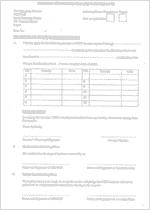When the Going Gets Tough, How to Switch Your Stockbroker
By SmartProInvesting.com Stock Investing Team.
May 2, 2008
Many investors have loads of complaints about their stockbrokers, often suggesting itís much of an uncomfortable marriage. Mostly, they try to cope with the brokerís shortcomings, albeit with a lot of pain.
Much of the problem, from complaints we receive, would seem to bother on customer service. With many stock houses, service is just miserable, as standards have remained unbearably low. Even when you struggle to follow up on transactions, responses could be unfriendly, unsatisfactory or outright inappropriate. Because investors bump into similar problems with other stockbrokers, the wisdom has often been to keep managing.
That changes, though, when fundamental problems arise. Problems of irreconcilable differences that lead to complete breakdown of the relationship do occasionally occur. Of course some end up in adjudication by regulatory or judicial authorities, but it may just require only switching your broker. If oneís stocks are sold without authorization, for instance, a fundamental breach of confidence arises which is likely to damage the relationship irretrievably. The need for a new stockbroker may arise. Since some stocks are held in account with the current stockbroker, a process to transfer them to another broker will be required.
How it Works
Opening an account with a new stockbroker is hardly a problem. Once you meet the requirements of the broker (say, as to minimum funding), it takes completing simple forms, with which a new CSCS account is processed for you. That done, the new stockbroker can execute new orders for you. However, stocks in your old CSCS account remain in the name of the previous stockbroker, which means you canít yet transact on them, except through the previous broker that your have chosen to jettison. You will need to transfer them to the new stockbroker.
The Account Transfer Process
 The CSCS will transfer your stocks to your account with the new stockbroker, once the account transfer form has been duly executed - see specimen of form to the left; click for a printable copy. The only problem is that the form, which is first completed by you, must be counter-signed by your previous stockbroker. In effect, that broker must give their consent. The receiving (new) stockbroker will also endorse. The CSCS will transfer your stocks to your account with the new stockbroker, once the account transfer form has been duly executed - see specimen of form to the left; click for a printable copy. The only problem is that the form, which is first completed by you, must be counter-signed by your previous stockbroker. In effect, that broker must give their consent. The receiving (new) stockbroker will also endorse.
The good news is that your previous stockbroker doesnít have the discretion to just refuse to assent to a transfer. He can only do so if there is a valid basis. For instance, if you owe them. In any case, what will be expected is that you clear whatever outstanding issues there are and your form gets endorsed. If it finally boils down to intransigence Ė broker has no ground for refusal but chooses to Ė you possibly will need the intervention of the regulators. The complaints unit at the Nigerian Stock Exchange, for instance, should be able to help resolve it.
Forms Signed
Once your transfer form is counter-signed by the previous stockbroker, it only needs to be submitted to the CSCS which will effect the necessary transfer to the new account with the new stockbroker.
|
|

